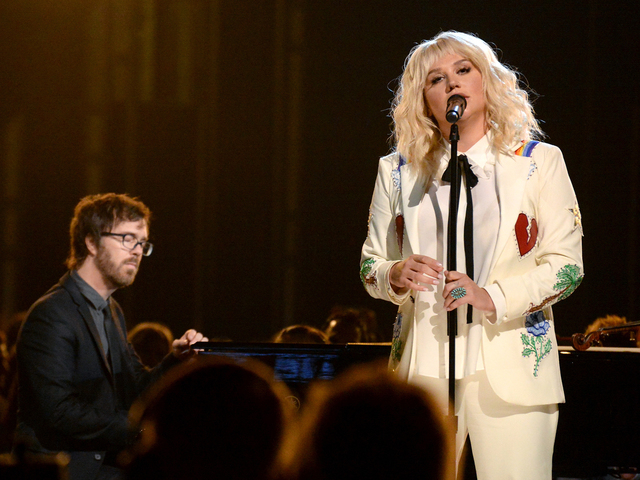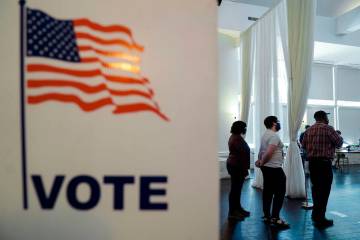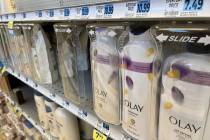UNLV professor targets ‘wasteful’ dipper wells
Before you even take that first sip of latte or bite of hand-scooped ice cream, you may have unwittingly participated in a form of water waste as common as your corner coffee shop.
Each year, food establishments across the valley purposely pour more than 100 million gallons of drinking water down the drain in the interest of health and expedience, according to a UNLV professor and a student who want to shut the tap on the practice.
The culprit is a kitchen convenience known as a dipper well, which uses a continuous stream of cold water to rinse ice cream scoops and other utensils.
Martin Dean Dupalo, an adjunct professor of political science at the University of Nevada, Las Vegas, and Nathan Sipe, one of his students, spent about three months trying to determine how many dipper wells there are in the valley and how much water they use.
After several hundred hours of research, none of it paid, they settled on three numbers: 2,453 dipper wells at 1,134 food establishments sending 106.4 million gallons of drinking water a year down the drain.
That's enough water to supply 653 average homes.
And Dupalo considers that "a bare minimum." It's a conservative figure they settled on because it could be defended by their research, he said.
Dipper wells are especially common at ice cream shops and specialty coffee houses. Starbucks was blasted in the British media last year for its use of the small, perpetual-flow sinks, but the coffee chain is hardly alone.
"I think the big thing that surprised me was how many businesses used these," Sipe said.
In the course of their research, he and Dupalo found at least one restaurant with five dipper wells running at once, including a well used exclusively for potato slicers.
They also came across several coffee kiosks inside grocery stores and elsewhere that left their dipper wells running all the time, even when the businesses were closed.
Dupalo said the wells make no sense, especially in a place where residents are encouraged to quickly repair slow drips and turn off the tap while they brush their teeth.
"We're in the desert, and we're in a multiyear drought," he said.
Dupalo and Sipe finished their study in April and have been trying to get it on the agenda for the Southern Nevada Health District ever since.
After the health district, they plan to present their findings to the Southern Nevada Water Authority and the Clark County Commission.
Ultimately, Dupalo would like to see dipper wells banned from new businesses and phased out of old ones.
Paul Klouse is an environmental health supervisor for the health district. He couldn't speak to likelihood of a ban on dipper wells, but he said the argument against them makes "absolute sense from a water conservation perspective."
"The regulations do not require dipper wells," Klouse said. "There are lots of alternatives to running them."
Water authority Conservation Manager Doug Bennett hasn't seen Dupalo and Sipe's findings, but he knows plenty about dipper wells already.
"Well, they are horribly wasteful," he said.
They are also inefficient. Because a dipper well runs all the time, Bennett said, "it's going to use that water whether you serve four scoops of ice cream or you serve 4,000 scoops of ice cream in a day."
Starbucks has gotten the message.
Earlier this year, the company began implementing alternatives to dipper wells, including more traditional rinse sinks and the use of a separate utensil for each drink that is made.
Starbucks hopes to be able to shut off the dipper wells at all of its locations in the United States by September. After that, the ubiquitous coffee chain plans to start converting its international shops.
Starbucks could qualify for a little help from the water authority as it makes the switch from dipper wells in Southern Nevada, Bennett said.
Through its WET program, short for Water Efficient Technologies, the authority offers rebates to businesses that replace older, less efficient water systems and cut their water use by at least 500,000 gallons a year.
Bennett said a chain of restaurants or coffee shops could easily save that much merely by replacing the dipper wells at its valley locations.
A small, family-owned coffee shop or ice cream parlor also might be able to earn a rebate by getting rid of its dipper wells and making other water efficiency improvements, he said.
Dupalo hopes businesses will decide to make the change on their own, but a complete, valleywide conversion will never happen without a firm push from regulators.
As it stands now, he said, dipper wells are "unregulated, unmonitored and continuous flow," words that should never be used when it comes to managing water in North America's driest desert.
Contact reporter Henry Brean at hbrean @reviewjournal.com or 702-383-0350.





























